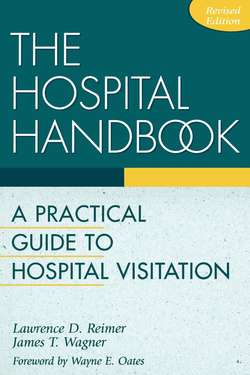Читать книгу Hospital Handbook - James T. Wagner - Страница 15
На сайте Литреса книга снята с продажи.
People Who Can Help
ОглавлениеWhen you arrive in a new community, establish a plan to get acquainted with the hospitals and physicians who care for your congregation. Such a plan should begin with the physicians who are members of your congregation. Ask your parishioners for other names of the community's respected doctors as well. Call these key medical people and ask for an opportunity to meet with them at their convenience. Breakfast, lunch, a cup of coffee after rounds at the hospital, are all possible times to introduce yourself. Let these physicians tell you about their community, the current issues at the local and regional hospitals, and the needs they see for visiting and pastoral care. Find out how to share information about patients when necessary. Ask for the names of other health professionals they feel you should meet. Use all these contacts as a time to get to know each other. Specific questions and critical concerns may arise later. These will be much easier to deal with if you have first established a firm base of personal trust.
Before your first hospital call, find someone who can give you an orientation to the hospital. In a large hospital this might be the chaplain. If there is no chaplain, there are social workers, administrators, and staff with a title such as hospital hostess who can give you a tour, explain that hospital's policies for clergy visits, and even help you find a place to park your car.
If you cannot find someone within the hospital to help, ask another pastor in the community. Along the way, make sure your guide introduces you to key hospital personnel. You will be spending a lot of time in the hospital. It is important for hospital staff to recognize you and for you to know whom to call when you have special concerns.
It is clear that many of the logistical elements of hospital visiting are determined by the size of the hospital, community, and church where you work. In Connecticut I was on the staff of a large church, in the largest denomination in the state, in a small town, in a small hospital. There was always someone to see in the hospital, so I just went regularly. I didn't always know everyone I saw, but the hospital personnel got to know me quickly. It was easy to find patients from my church in the visitor's directory. When I moved to Florida, I found myself in a community with four large hospitals, in a small church, of a denomination most people in the South had never heard of. My hospital visiting in Florida is much different. I clearly know everyone I visit, but someone has to let me know they are in the hospital. I have to keep making myself known to the hospital staff.
We will continue to apply criteria for hospital visiting to the entire range of situations in which hospital visitors find themselves. At this point, clarify your own situation, the setting in which you do your hospital visiting, and have a picture of it before you as you consider your orientation.
Begin by getting to know the people who can help. Cultivate an awareness of different professionals in the hospital system and use them regularly. People to contact are chaplains, social workers, nursing supervisors in particular units or areas, patient services representatives, and information hosts or hostesses.
